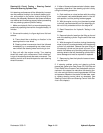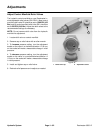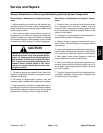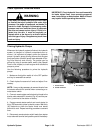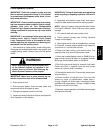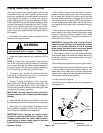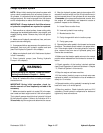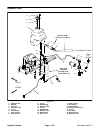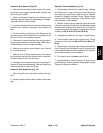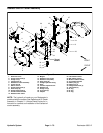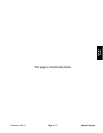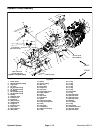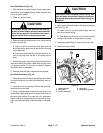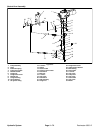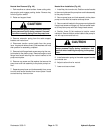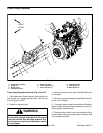
Reelmaster 3550−D Hydraulic SystemPage 4 − 69
Hydraulic Tank Removal (Fig. 42)
1. Park machine on a level surface. Lower cutting units,
stop engine and engage parking brake. Remove key
from the ignition switch.
2. Read the General Precautions for Removing and
Installing Hydraulic System Components at the begin-
ning of this section of this chapter.
3. To prevent contamination of hydraulic system during
hydraulic tank removal, thoroughly clean exterior of
tank.
4. To allow draining of hydraulic tank, disconnect the
suction hose from the tank strainer in the bottom of the
tank. Drain tank into a suitable container.
5. Disconnect hydraulic lines from tank and put caps or
plugs on open hydraulic lines and fittings. Label discon-
nected hydraulic lines for proper assembly.
6. Remove tank strainer from hydraulic tank. Discard
O−ring from strainer.
7. Remove four (4) flange head screws, flat washers
and grommets that secure hydraulic tank to machine.
Remove hydraulic tank from machine.
8. If fittings are to be removed from tank, mark fitting ori-
entation to allow correct assembly. Remove fittings from
tank and discard O−rings from fittings.
Hydraulic Tank Inspection (Fig. 42)
1. Clean hydraulic tank and suction strainer with sol-
vent.
2. Inspect hydraulic tank for leaks, cracks or other dam-
age.
Hydraulic Tank Installation (Fig. 42)
1. If fittings were removed from hydraulic tank, lubricate
and place new O−rings onto fittings. Install fittings into
tank openings using marks made during the removal
process to properly orientate fittings. Tighten fittings
(see Hydraulic Fitting Installation in the General Infor-
mation section of this chapter).
2. Position hydraulic tank to machine. Apply anti−seize
lubricant or equivalent to the four (4) flange head screws
that secure the hydraulic tank. Secure tank to frame with
flange head screws, flat washers and grommets. Torque
screws from 30 to 60 in−lb (3.4 to 6.8 N−m).
3. Lubricate and install new O−ring on suction strainer.
4. Thread suction strainer into hydraulic tank. Torque
strainer into tank port from 80 to 87 ft−lb (109 to 117
N−m).
5. Remove caps and plugs from fittings and hydraulic
lines. Properly connect hydraulic lines to hydraulic tank
(see Hydraulic Hose and Tube Installation in the Gener-
al Information section of this chapter).
6. Fill hydraulic tank with new hydraulic fluid.
7. Operate machine. Check hydraulic oil level and ad-
just if necessary. Check hydraulic components for leaks.
Tighten any loose connections.
Hydraulic
System



